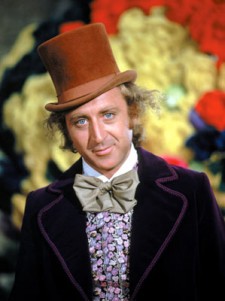How Much More Does Candy Cost Today?

“Candy may be dandy…” Actually, that is not true. Candy is at all times dandy, and all of us can testify to that: we were children once, and young. When I was ten I’d bike down to the Open Pantry, and if there was allowance left over after comic books, I’d grab a Reese’s Peanut Butter Cup for a quarter (and, if in a shrewd frame of mind, not eat it directly but throw it in the freezer back home). It was a tiny luxury, only two bits.
Now, 30 years later, with childhood more perilous than ever (what with the confusion over the aims of Occupy Wall Street, and the sexting), is candy still a tiny luxury, or are manufacturers of candy leveraging candy’s comfort into a gold-like inflation? Are even our children not safe from the predatory aspects of the free-market economy? Surely no corporation would be so Snidely Whiplash as to exploit little kids for profit, but let’s investigate anyway.
To measure relative prices through the decades, let’s stick with one representative candy: Reese’s Peanut Butter Cups. You may remember the tagline from the 1970s and early ’80s, “You got your chocolate in my peanut butter!” This was a bit misleading. The Reese’s Peanut Butter Cup experience does not purely consist of a young woman walking down the street eating peanut butter out of a jar, and a young man walking the other direction, chocolate bar in front of him like, um, a dowsing rod. I can’t be the only person who, back then, decided to mix chocolate chips with peanut butter out of a jar to see if I could fake a Reese’s Peanut Butter Cup, and found that, while not terrible, it was nothing like the real thing. The whole is greater than the parts, which is the mystery at the heart of candy bars, and Reese’s Peanut Butter Cup in specific.

Even with an informal survey like this one, which has been narrowed down to a single candy, it’s still not so easy to pin a historical trend down, as the cup is not the only chocolate/peanut butter delivery system that has been utilized by Reese’s. It was for a long time. H.B. Reese first sold the cups in 1920s, in Hershey, PA, using Hershey’s chocolate. The 1920s was an active decade for what we now think of as the candy industry (or, the confectionary industry, as it is known), with Baby Ruths, Heath Bars, Milk Duds, Mr. Goodbars and other candies being introduced. The subsectors of the confectionary industry include chocolate, non-chocolate, gum and snack/cookie/cracker products, which is apropos of nothing, but I do love a good subsector. In North America, the global confectionary industry pulled in $35.4 billion, and has expanded by 6% from 2005 to 2010. This data — as learned from appropriately named trade magazine Candy Industry — is offered to demonstrate that nothing manufactured and sold is so magical, not even candy, as to avoid being an “industry,” a word which evokes all kinds of things, all antithetical to candy.
H.B. Reese made other candies too, but the cups are what persisted, and remained the flagship, even after Hershey acquired the company in 1963. Starting in the ’70s, the Reese’s line diversified, and the branding started before we ever called it that. In addition to the cups came the Reese’s Pieces (popularized, if not saved, by the movie E.T., after M&Ms; turned them down) and various iterations of actual candy bars, like Reese’s Fast Break, Reese’s Nutrageous, Reese’s Whipps, Reese’s Wafer Bars and Reese’s Snack Barz. Not to mention the holiday and seasonal versions that are available. Of course we all know the Reese’s Peanut Butter Egg, which were the highlight of many an Easter basket, but have you heard of the Reese’s Peanut Butter Pumpkin? Or the Reese’s Peanut Butter Tree (which you probably have seen during the holiday season, but did you know that it’s called something as mundane as tree)? And there is even a Reese’s Peanut Butter Heart. This is no doubt a growth sector for Hershey, as those cover only four holidays, and we have many, many more. This might be a good chance to write a letter to Hershey and/or your congressman demanding a Reese’s Peanut Butter Back-To-School Sale Pencil Caddy, or a Reese’s Peanut Butter Abraham Lincoln.

But sticking with only the Reese’s Peanut Butter Cups, the normal ones, the ones that have been around for nearly 90 years: how much did they cost way back when? According to this bio of Harry Burnett Reese, at roughly the time the peanut butter cups were introduced (and it’s a bit messy, as he alternately sold them at small shops locally and to assortment lines for packaging), they were going for a penny a cup. That seems reasonable, so let’s use it as a baseline.
Though mention must be made of certain problems when trying to ascertain consumer products vended nationally: namely, it was a big country, even back then, and, as such, retail prices varied. Even if sold nationally through a rigid distribution system, the retail price of a product was (and is) up to the seller. So was maybe a Reese’s Peanut Butter Cup sold in 1928 for 2¢, or even 5¢ in some places? Sure. But for our (unscientific) purposes, leaps of faith must be made. A penny is as good a place to start as any, because you can’t go lower than that.
Moving forward, polling my parents and my friends’ parents, I found vague agreement that, by 1955, the going price for a Reese’s Peanut Butter Cup, or a candy bar in general, was five cents. I am not going to argue with my parents and the parents of my friends.
In fact, if we are going to assume an equivalency between Reese’s Peanut Butter Cups and candy bars in general (which accords with my own personal memory, and visits to shops researching this article), let’s look at this valuable resource from the website The Food Timeline. It’s The Hershey Bar index, comprised of information given from The Hershey Company itself. It confirms the five-cent price, and then has the price rise to ten cents around 1969. After than, we will ratify the price index levels with our own personal memory: $.25 in 1979 (as mentioned above), up to $.45 by 1991 and $.80 by 2003.
And to jump to now, I stopped in at various locations both in Manhattan and Brooklyn, in nice neighborhoods and less posh environs, and, just as our retail conundrum would predict, prices indeed do vary. Reese’s Peanut Butter Cups are going for anywhere between $.89 and $1.50 in Manhattan, and from $.80 to $1.39 in Brooklyn. So to be lazy and take the average of those four numbers, we get $1.14.
So then, let’s consult the handy Bureau of Labor Statistics consumer price index calculator and run the numbers, giving each of the prices in 2011 dollars:
1928: $.13
1955: $.42
1969: $.61
1979: $.78
1991: $.75
2003: $.98
2011: $1.14
Well then, that’s a pretty obvious trend. I expected these figures to be roughly a gentle increase, mostly because there’s a certain squishiness about serving size — at some point the default Reese’s package contained two cups and instead of one. Also, the actual size of the product does fluctuate over time (see again the Hershey Index). But that increase is not gentle at all. Even if we disregard the 1928 figure as an outlier from a time when national distribution was not the ubiquity it is today, we’re looking at an increase of 271% over the 56-year span between 1955 and now, and not in then-current prices, but in numbers adjusted for the natural skew of inflation.
A dollar and change may not seem like much. In fact, it’s not much, these days. Say you were ten years old in 1989, today’s dollar was then fifty-five cents. So if your niece really really wants a Mounds? No problem, once you’ve convinced her to have a Reese’s Peanut Butter Cup instead. But considering that the real price of this specific candy, the friend of children everywhere, has tripled in the span of a couple generations, it’s pretty clear that children are not primarily thought of as cute and occasionally loud creatures that people have when they settle down, but rather a lucrative market demographic.
